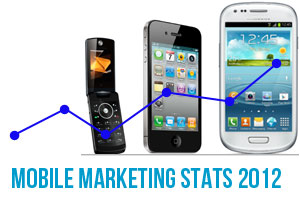Mobile Marketing Statistics 2012

Gone are the days of traditional marketing techniques as the only means of attracting clients and customers. Sure, traditional marketing still definitely has its place in the world, but marketing companies have seen huge growth in marketing by way of mobile marketing. Not so sure? Come check out our Mobile Marketing Statistics 2012 and see for yourself. Even if you’re not quite ready to take the jump into mobile marketing, these stats are sure to help you see just how big mobile marketing has gotten, and the fact that it’s not going anywhere but up.
According to Hubspot, almost half of all U.S. businesses (more specifically 45%) are using some form of mobile marketing. Of all marketing agencies out there, about 47% of them plan to step up their mobile game in 2013. The most common forms of mobile marketing are as follows: Mobile websites come in first at 70%, Mobile Applications come in second at 55%, and QR Codes come in a close third with 49%. Mobile marketing is expected to account for roughly 25% of overall E-commerce revenues by the end of 2017. By the year 2016, mobile marketing advertising revenue worldwide is expected to expand by over 3.5 times it’s current size.
So how does it work?
For starters, you’ve gotta have that little gadget that everyone is so attached to–that no one can leave home without : their cell phone. Of the four billion cell phones out there (yes, you read that right, four billion), over a quarter of these are smartphones. Of those one billion smartphones, roughly 75% of those are either iPhones or Android powered phones. Over 75% of those total phones have text messaging (sms messaging) enabled.
Think about that for a minute: over 3 billion people can send and receive SMS messages at any time, day or night. What that means for you: the marketing messages you’re trying to get out there could be sent to almost half the world in mere seconds. Another perk of SMS marketing is that those messages are going directly to your clients and customers instead of possibly being filtered off into a spam folder, tossed out, or ignored like some traditional advertising outlets can be.
So with four billion mobile phones out there, what are their owners doing with them? Aside from just talking on them, many cell phone users are browsing the web, checking email, and using apps and mobile codes to help them shop.
Mobile web usage is up almost 70% from where it was in 2010. In the United States, about 8% of all web traffic comes from mobile users, up from 4.7%. Specifically, 14.6% of that mobile internet traffic is from smartphones, and 5.6% is from other mobile devices, such as tablets. Worldwide, mobile web traffic is up to 10%, over 160% more than where it was in 2010.
Of all local searches performed today, about half are done via mobile. Customers also shop around using their phone–either by a search, or by a native application. They’re checking online reviews and doing price checks while in store. One in five smartphone users said they would scan product barcodes, one in eight uses an application to do price comparisons. 29% of mobile users said they would scan a mobile tag, text in a keyword, or scan a QR code to receive coupons or discounts from a company.
Speaking of QR codes: 50% of smartphone users said that they have scanned a QR code. 80% of Americans can identify a QR code when they see one. QR code scans are up to almost 20%, up from under 14% (where they were at in April of 2011) in the United States alone.
Any company can benefit from mobile marketing, and these stats definitely go to show that mobile is here to stay. Hopefully they showed you that you should consider adding mobile marketing to your marketing plans today!








With all the hype about mobile you would think that a great mobile marketing business opportunity would be selling mobile websites, QR codes or other mobile marketing services to local businesses. The fact is most businesses have no clue how mobile is going to help their business and they are slow to adapt this new technology.